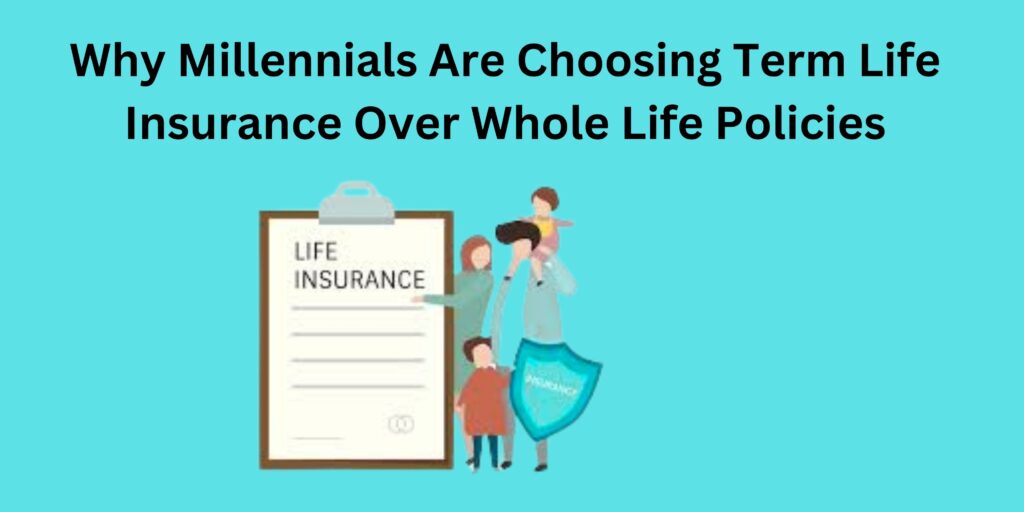Millennials are redefining the way financial products are perceived, and life insurance is no exception. Unlike previous generations who leaned towards whole life policies, millennials are increasingly opting for term life insurance. But what is driving this shift? Is term life insurance truly the better option for younger generations? In this article, we will break down the key reasons why millennials prefer term life insurance, how it benefits them, and what makes it a smarter choice for modern financial planning.

Understanding Term Life vs. Whole Life Insurance
Before diving into why millennials favor term life insurance, let’s understand the basic differences between term life and whole life policies.
Term Life Insurance
- Provides coverage for a specific period (e.g., 10, 20, or 30 years).
- More affordable compared to whole life insurance.
- Pure insurance with no cash value component.
- Payout occurs only if the policyholder passes away during the policy term.
Whole Life Insurance
- Provides lifetime coverage.
- Includes a cash value component that grows over time.
- Significantly more expensive than term life insurance.
- Considered both an insurance product and an investment.
Now that we have a clear understanding of both types, let’s explore why millennials overwhelmingly prefer term life insurance.
Why Millennials Are Choosing Term Life Insurance
1. Affordability: The Budget-Friendly Option
Millennials are at a stage in life where they are managing student loans, rent, and rising living costs. Whole life insurance premiums can be 5-10 times higher than term life insurance, making them unaffordable for many young professionals. Term life insurance provides high coverage at a low cost, allowing millennials to secure financial protection without straining their budgets.
Real-World Example:
Sarah, a 30-year-old software engineer, compared a $500,000 policy. A 20-year term life policy cost her just $25 per month, while a whole life policy for the same coverage was nearly $400 per month. She opted for term life and invested the difference in a high-yield savings account.
Read more
- Best Senior Citizen Travel Insurance Plans for International Trips in 2025
- Top 5 Travel Insurance Companies Offering Best Plans for Senior Citizens
2. Simple and Easy to Understand
Millennials appreciate transparency and simplicity in financial products. Whole life insurance can be complex, with cash value components, investment growth rates, and surrender charges. Term life, on the other hand, is straightforward—pay your premium, get coverage, and if anything happens within the term, your beneficiaries receive the payout.
3. Focus on Financial Independence and Investments
Millennials prioritize financial independence and prefer to invest on their own terms rather than relying on an insurance policy’s built-in investment feature. With a variety of investment options available, such as index funds, ETFs, and cryptocurrencies, millennials find greater flexibility in managing their wealth outside of a life insurance policy.
4. Changing Career Paths and Uncertain Income
Unlike previous generations who stayed in one job for decades, millennials frequently change careers and explore new opportunities. With fluctuating incomes, a costly whole life insurance policy can feel like a burden. Term life insurance allows them to maintain coverage without locking themselves into an expensive commitment.
5. Better Alternative for Debt Protection
Many millennials carry student loans, car loans, and mortgages. Term life insurance ensures that in the event of their untimely death, their debts won’t become a financial burden on their loved ones.
6. Flexibility in Coverage Duration
Millennials tend to choose financial products that match their life stages. Since term life insurance is available in different durations (10, 20, or 30 years), they can tailor their coverage to their current needs and reassess as their financial situation changes.
7. The Rise of Digital Insurance Providers
With advancements in technology, purchasing term life insurance has become easier than ever. Many companies offer instant quotes and online applications, removing the need for traditional agents. Millennials, who are tech-savvy, appreciate the convenience and speed of digital platforms.
How Millennials Can Choose the Right Term Life Insurance
If you’re considering term life insurance, here’s a simple step-by-step guide to help you choose the right policy:
- Assess Your Needs – Determine how much coverage you need based on your debts, income, and family’s financial needs.
- Compare Quotes Online – Use comparison websites to check different policy rates and benefits.
- Check the Insurer’s Reputation – Ensure the provider has a strong financial rating and positive customer reviews.
- Select the Right Term Length – Choose a duration that aligns with your financial obligations.
- Look for Additional Riders – Some policies offer riders like critical illness coverage, which may be beneficial.
FAQs
Yes, term life insurance is a cost-effective way to secure financial protection without locking into a costly lifelong commitment.
Once the term expires, coverage ends. You may have options to renew, convert to whole life insurance, or purchase a new policy.
Even if you don’t have dependents, a policy can help cover debts, funeral costs, and provide financial security for co-signers on loans.
Some policies offer conversion options, allowing you to switch to whole life insurance without a medical exam.
The earlier, the better. Buying in your 20s or 30s locks in lower premiums compared to purchasing later in life.
Conclusion
Millennials are embracing term life insurance because of its affordability, simplicity, and flexibility. Unlike whole life insurance, which can be expensive and complex, term life insurance provides pure protection without unnecessary investment components. With the rise of digital insurance platforms, securing a policy has never been easier. If you’re a millennial considering life insurance, term life might be the smartest financial decision you make today.
